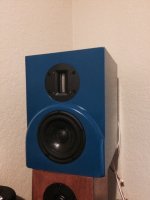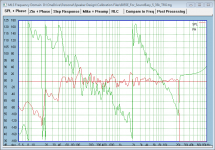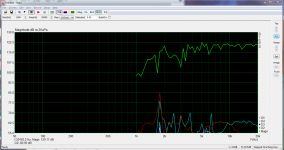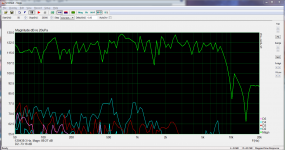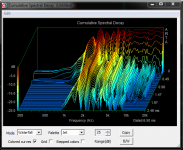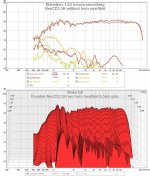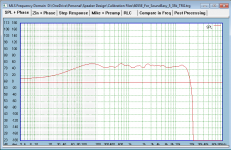I'm working on designing a crossover for the 15W/8530k00 and Fountek NeoCD3.0 tweeter speaker shown in the attachment. I've been using miniDSP to try to find an agreeable crossover frequency/slope as well as any attenuation and notch filters I'll need before designing the passive crossover. The SS 15W is a dream, it sounds wonderful with simple baffle step compensation. Can't believe I've had it sitting on a shelf for years!
However, the NeoCD3.0 measures pretty flat (+/- 2dB) in my rig but there is just something annoying 6-7k that is not frequency response. I can make it better by notching, but it seems like this issue is at 12k too. I guess I need to run distortion tests but I can't get away with distortion sweeps until I send the wife and kids out for a few hours Any experience with this NeoCD3.0? I really like the way 12dB/octave at 3khz sounds in this pair with the exception of this high frequency ick. I know that this is below the recommended frequency/slope but it sounds better and this is for near-field listening. I hear the same 6-7k issues if I switch to 4th order crossover or increase the crossover frequency to 4th order 4k so it's probably not harmonically related to 3k. Any suggestions? I'm really not wanting to cross too high as I care about the power response? I have a Seas millennium with the same size faceplate if worse comes to worse.....
Any experience with this NeoCD3.0? I really like the way 12dB/octave at 3khz sounds in this pair with the exception of this high frequency ick. I know that this is below the recommended frequency/slope but it sounds better and this is for near-field listening. I hear the same 6-7k issues if I switch to 4th order crossover or increase the crossover frequency to 4th order 4k so it's probably not harmonically related to 3k. Any suggestions? I'm really not wanting to cross too high as I care about the power response? I have a Seas millennium with the same size faceplate if worse comes to worse.....
However, the NeoCD3.0 measures pretty flat (+/- 2dB) in my rig but there is just something annoying 6-7k that is not frequency response. I can make it better by notching, but it seems like this issue is at 12k too. I guess I need to run distortion tests but I can't get away with distortion sweeps until I send the wife and kids out for a few hours
Attachments
My guess is that you hear baffle edge diffraction interferences. The driver itself is ok and when you are in nearfield, diffractions don't get enough distance and space to get mixed (to generate farfield power response).
Likewise, notice the shape of 60¤ response of 15W http://www.scan-speak.dk/datasheet/pdf/15w-8530k00.pdf
Have you checked step response, is time delay difference correct for M and T? It is very sensitive around 3kHz! If it is full cycle off, you will get interference dips and peaks in summed treble response!
Take measurements with short IR gating (4-6ms) at various angles at 0.5 to 1m distance. You should be able to see lots of variations in treble response .
Likewise, notice the shape of 60¤ response of 15W http://www.scan-speak.dk/datasheet/pdf/15w-8530k00.pdf
Have you checked step response, is time delay difference correct for M and T? It is very sensitive around 3kHz! If it is full cycle off, you will get interference dips and peaks in summed treble response!
Take measurements with short IR gating (4-6ms) at various angles at 0.5 to 1m distance. You should be able to see lots of variations in treble response .
Last edited:
CSD
So I took measurements from various locations and the drivers seem to sum pretty well at my listening position. I've attached a response graph at the listening position which shows decent in-room frequency/phase response. This was captured when I had the xo set to 2500Hz but the poor upper treble sound persists. Even tried 2200Hz 4th order to no avail... I don't think I can go any lower with this tweeter....
I was able to run distortion measurements on both drivers and nothing really stands out that wasn't already known. The low end of the ribbon is a little rough but otherwise it all looks pretty decent.
I ran CSD and that is where things got interesting. The Neo3CD seems to ring like a bell. I'm pretty confident it's not cabinet resonance as the minimum baltic birch width is 3/4" but much of the cabinet has 2x3/4". There is a cross brace inside and commercial fabric padding on the side walls.... Guess I need to invest some time and money into an accelorometer to really know for sure
To be fair, this CSD was run in room and not in my typical measurement setup however the first reflection in the IR was gated out..... I've done many, many CSD measurements and this is the first time I've seen something that looked this bad......
So I took measurements from various locations and the drivers seem to sum pretty well at my listening position. I've attached a response graph at the listening position which shows decent in-room frequency/phase response. This was captured when I had the xo set to 2500Hz but the poor upper treble sound persists. Even tried 2200Hz 4th order to no avail... I don't think I can go any lower with this tweeter....
I was able to run distortion measurements on both drivers and nothing really stands out that wasn't already known. The low end of the ribbon is a little rough but otherwise it all looks pretty decent.
I ran CSD and that is where things got interesting. The Neo3CD seems to ring like a bell. I'm pretty confident it's not cabinet resonance as the minimum baltic birch width is 3/4" but much of the cabinet has 2x3/4". There is a cross brace inside and commercial fabric padding on the side walls.... Guess I need to invest some time and money into an accelorometer to really know for sure
To be fair, this CSD was run in room and not in my typical measurement setup however the first reflection in the IR was gated out..... I've done many, many CSD measurements and this is the first time I've seen something that looked this bad......
Attachments
Nope, just tested one channel. It seems like it should be a measurement anomaly given the other measurements. I'm going to have to take them outside and measure them without boundaries close by. The measurement was gated where the first reflection was evident....... I'll dig in and figure out what's going on. Maybe replace that speaker with another one I've designed and previously measure for a sanity check.
Sent from my iPhone using Tapatalk
Sent from my iPhone using Tapatalk
I really don't know what you are doing with those waterfall plots, but the fact is the Neo CD3 ribbon tweeter just lets out a lot more energy above 3Khz.
Monitor W15NeoSEAS W15CY001 +
Troels Gravesen is a pretty straightforward guy. If the tweeter is doubling the desired power above 3kHz, he just halves it with an LR shelf filter. Then it sounds about right. Not hard.
Monitor W15NeoSEAS W15CY001 +
Troels Gravesen is a pretty straightforward guy. If the tweeter is doubling the desired power above 3kHz, he just halves it with an LR shelf filter. Then it sounds about right. Not hard.
Aye, I just looked at the gate time in ms at the bottom of the graph. 6.5ms is way too long of a window time given the mic/speaker setup. Sorry for the confusion, this is what happens when trying to finish this with two kids tugging on me to come play I'll have to retry this tomorrow. I'm sure I'll get better results when I clean up the window time.
I'll have to retry this tomorrow. I'm sure I'll get better results when I clean up the window time.
WRT waterfall plots, I find them very useful personally. They do a good job of showing how a speaker responds in the time domain and are more informative than just looking at an IR. I'm no expert, but I expect to see super fast decay with ribbons. I think it is this ability to start and stop quickly that make them sound so different. Of course vertical polar response and distortion tend to be better in domes so I'm not saying one is better than the other but they are definitely different
I'm using miniDSP to help me decide on the future passive crossover properties. I don't feel like there is too much energy above 3k necessarily. My ears just tell me that there is something annoying sounding that gets marginally better when I notch 6 and 12k even though they look pretty flat in my frequency response graphs... Even when I move the mic around and set a small window... I'm having a hard time making sense of this but I know I hear something I don't like and I've tried a ton of different XO frequencies/slopes, notch filters and shelf filters. I can't find a combination I'm happy with. Maybe the NeoCD3.0 is better suited to 5k+ duty as some have suggested. Measurements don't tell the whole story, intermodulation distortion is way more offensive than harmonic distortion but is pretty tough to measure and it's rarely even considered. I'm beginning to think I'm just not a fan of this tweeter.
Speaking of Troels, this design is based lightly on the Ellam Flex project in terms of stepped baffle, baffle width and bass tuning. He's a very good designer and I've followed his site and learned much from him over the years. In fact, I've used his crossover topologies as a starting point in my crossover simulation routine with much success. I almost pulled the trigger on the DTQWT but decided to upgrade my Orions to LX521 instead. I'll always wonder what those DTQWT's sound like though
WRT waterfall plots, I find them very useful personally. They do a good job of showing how a speaker responds in the time domain and are more informative than just looking at an IR. I'm no expert, but I expect to see super fast decay with ribbons. I think it is this ability to start and stop quickly that make them sound so different. Of course vertical polar response and distortion tend to be better in domes so I'm not saying one is better than the other but they are definitely different
I'm using miniDSP to help me decide on the future passive crossover properties. I don't feel like there is too much energy above 3k necessarily. My ears just tell me that there is something annoying sounding that gets marginally better when I notch 6 and 12k even though they look pretty flat in my frequency response graphs... Even when I move the mic around and set a small window... I'm having a hard time making sense of this but I know I hear something I don't like and I've tried a ton of different XO frequencies/slopes, notch filters and shelf filters. I can't find a combination I'm happy with. Maybe the NeoCD3.0 is better suited to 5k+ duty as some have suggested. Measurements don't tell the whole story, intermodulation distortion is way more offensive than harmonic distortion but is pretty tough to measure and it's rarely even considered. I'm beginning to think I'm just not a fan of this tweeter.
Speaking of Troels, this design is based lightly on the Ellam Flex project in terms of stepped baffle, baffle width and bass tuning. He's a very good designer and I've followed his site and learned much from him over the years. In fact, I've used his crossover topologies as a starting point in my crossover simulation routine with much success. I almost pulled the trigger on the DTQWT but decided to upgrade my Orions to LX521 instead. I'll always wonder what those DTQWT's sound like though
I have used Fountek NeoCD3.5H also without the horn. Nearfield response looks a lot like NeoCD3.0. Resonance at 1,5kHz is huge, LR2@3000 is definitely out of question. Acoustic LR4 around 3000Hz could be minimum. The horn gives huge boost for low freq, this version can be played much louder or crossed lower with eq'd response.
Here is my csd and distortion without the horn. Looks pretty much like jf's NeoCD3.0
Here is my csd and distortion without the horn. Looks pretty much like jf's NeoCD3.0
Attachments
Happy Easter all! Just an update.... I've been playing with this Neo for quite a few days trying everything imaginable and nothing sounded quite right.
I dropped the Seas Millennium in and set the XO to 2nd order at 1.5kHz. Left BSC in place and took a guess on the attenuation for the tweeter in miniDSP. Amazingly, my first try I got the attached response graph (note this one is using 1/12th octave smoothing but looks better because I'm measuring from the center of the room and reflections properly)! This combo sounds waaaaay better then the NeoCD3.0. The 15W/8530k00 is much happier with a tweeter that digs deeper and my ears are very happy, especially considering the phase all lines up nicely. Hopefully I can execute the passive XO as well as it sounds with miniDSP. This is a formidable bookshelf.
I have a couple pairs of W4-1720's hanging around so I'll probably do something like the speedster with the NeoCD3.0's as I can probably squeeze a little higher crossover out of the W4.
BTW, has anyone ever used Scanspeak and Seas in the same project? I feel like it must be faux pas or something as I can't think of a single project that uses both
I dropped the Seas Millennium in and set the XO to 2nd order at 1.5kHz. Left BSC in place and took a guess on the attenuation for the tweeter in miniDSP. Amazingly, my first try I got the attached response graph (note this one is using 1/12th octave smoothing but looks better because I'm measuring from the center of the room and reflections properly)! This combo sounds waaaaay better then the NeoCD3.0. The 15W/8530k00 is much happier with a tweeter that digs deeper and my ears are very happy, especially considering the phase all lines up nicely. Hopefully I can execute the passive XO as well as it sounds with miniDSP. This is a formidable bookshelf.
I have a couple pairs of W4-1720's hanging around so I'll probably do something like the speedster with the NeoCD3.0's as I can probably squeeze a little higher crossover out of the W4.
BTW, has anyone ever used Scanspeak and Seas in the same project? I feel like it must be faux pas or something as I can't think of a single project that uses both
Attachments
Last edited:
T have seen a distortion measuring plot here: https://www.intertechnik.de/Shop/Lautsprecher/Fountek/_NeoCD30_1768,de,6981,123573
The distortion rises below 4.0kHz.
The distortion rises below 4.0kHz.
I use the neo 3.5h also, and I have also read warnings to not use below recommended slopes and Fc, there is large energy storage around 2k. So use them way above this, at least an octave. I haven't used the ribbon without horn, although I have been thinking of trying a larger horn.
I am.not surprised there is a resonance, all drivers have Fs.... Stay away from it???
I am.not surprised there is a resonance, all drivers have Fs.... Stay away from it???
I agree its a difficult driver to match to a midbass, but I think it is worth the effort.
I tried both 2nd and 3rd order slopes at 4k and 3.5k respectively. The former matched phase better to my ear, but the 3rd order cleaned up the HD at the bottom end. Even so, with such good efficiency and when using a typical efficiency midbass, the 3.5h sounded unstrained. (I had a similar issue of stretching a midbass to play higher than it really likes, but instead I accepted a dip at xo point in an attempt.to assess the ribbon behaviour)
I think it would be far better and quite achievable to xo at 4k 4th order, as a minimum for a clean sound. But would the midbass increasing directivity mar the result? I have yet to find out, I preferred to accept the 'BBC dip', and avoid the nasties in both drivers responses at extremes during the small.amount of listening I have done.
I tried both 2nd and 3rd order slopes at 4k and 3.5k respectively. The former matched phase better to my ear, but the 3rd order cleaned up the HD at the bottom end. Even so, with such good efficiency and when using a typical efficiency midbass, the 3.5h sounded unstrained. (I had a similar issue of stretching a midbass to play higher than it really likes, but instead I accepted a dip at xo point in an attempt.to assess the ribbon behaviour)
I think it would be far better and quite achievable to xo at 4k 4th order, as a minimum for a clean sound. But would the midbass increasing directivity mar the result? I have yet to find out, I preferred to accept the 'BBC dip', and avoid the nasties in both drivers responses at extremes during the small.amount of listening I have done.
- Status
- This old topic is closed. If you want to reopen this topic, contact a moderator using the "Report Post" button.
- Home
- Loudspeakers
- Multi-Way
- NeoCD3.0 Experience?
